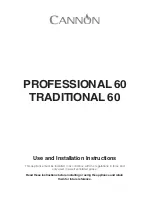
Instructions for use, installation and connection
106
Prior first use
Glass ceramic hob
Wipe the glass ceramic surface with moist cloth and some
dishwashing detergent for manual wash. Never use any
aggressive detergents, like powder detergents, rough dish
sponges producing scratches, rust removers or stain removers.
Oven
Take all the accessories out of the oven and clean it with warm
water and your usual mild detergent. Never use aggressive
cleaners as they might cause scratches!
During the first heating the oven might produce a somewhat
unpleasant smell of a new product. This is normal, just
ventilate the place thoroughly!
Energy saving tips
The bottom of the dish is too
thin and becomes crooked in the
process of heating up. The
consequence is excessive
consumption of energy and
uneven distribution of heat.
incorrect
The dish is too big or too small.
Temperature resistant glass,
protruding over the edge, might
break. Dish with too small
bottom diameter excessively
consumes energy and is not
economical.
incorrect
Adequate size of cooking
dishes.
Below are some important
suggestions how to use your
new cooker and its accessories
in order to save as much energy
as possible.
correct
Stick to the general rule:
The better the quality of the dish, the lower consumption of
energy!
Tips for purchasing crockery
•
Good quality dishes feature thick flat bottom. Uneven
bottom of the dish causes increased consumption of energy
and extended cooking time.
•
When purchasing new crockery carefully check if the
diameter quoted refers to the upper rim or the bottom. The
latter is usually always smaller.
•
Use of pressure cookers additionally saves energy, since
food is prepared in a closed dish and under pressure.
Furthermore, shorter cooking time preserves the vitamin
contents.
•
When using high radiation (bright metal surface) crockery, or
thick bottom dishes for preparing food on the glass ceramic
hob, the period of reaching the boiling point may be
prolonged for certain time (up to 10 minutes). Consequently,
if you need to boil considerable amount of liquid, it is
recommended to use the dark, flat bottom pot.
Tips for the use of oven
•
If possible use dark, silicone coated or enamel baking pans,
because of their excellent thermal conductivity.
•
Preheating of oven is necessary only if recommended by the
recipe or if written in the chart below.
•
Heating of empty oven consumes a lot of energy. Save it by
baking several pizzas or cakes consecutively, one after the
another, while the oven is still warm from the previous one.
Tips for effective use of crockery
•
Cooking zones should never be left empty when switched
on.
•
The best transfer of energy is obtained if the bottom
diameter of the dish is identical to the hotplate diameter, and
if the dish is placed exactly in the center of the hotplate.
•
Pots and pans may have larger diameter than the hotplates,
but they may never have smaller diameter, since this causes
loss of energy. Moreover, the glass-ceramic hob may be
damaged due to the improper transfer of energy.
•
The dish size should always suit the quantity of food.
Excessively big pot wastes too much energy.
•
Reduce power regulation towards the end of cooking, and
switch the hotplate off before cooking is complete, to be able
to use the remaining heat.
•
Always provide adequate quantity of water when cooking in
the pressure cooker. Lack of water may cause damage to
the dish and to the hotplate.
•
Temperature resistant glass cookware is suitable for use
with the hotplate if the bottom diameter of such dish is
adequate to the diameter of the hotplate. Dish protruding
over the hotplate edge may break as a consequence of
created thermal tension.
•
When using special cookware, always follow the
manufacturer's instructions.


































